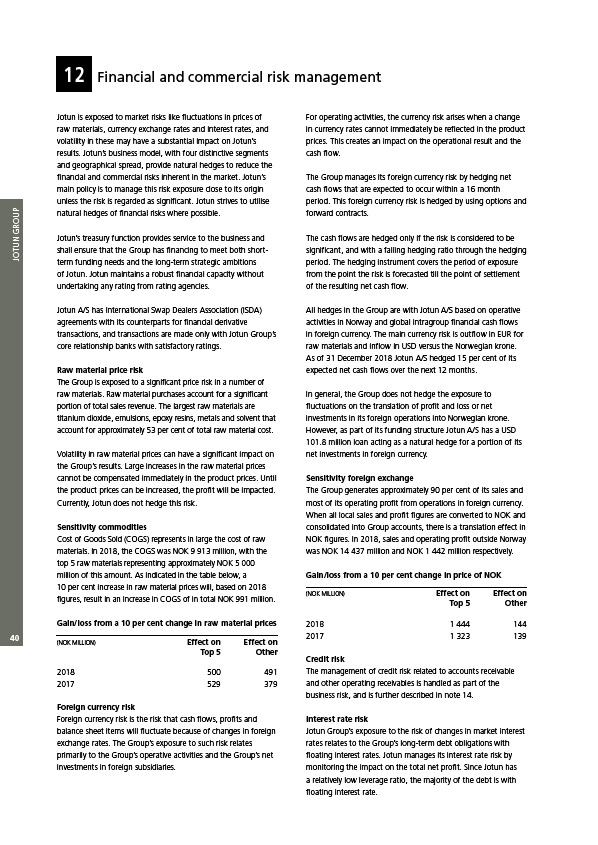
JOTUN GROUP
40
12 Financial and commercial risk management
Jotun is exposed to market risks like fluctuations in prices of
raw materials, currency exchange rates and interest rates, and
volatility in these may have a substantial impact on Jotun’s
results. Jotun’s business model, with four distinctive segments
and geographical spread, provide natural hedges to reduce the
financial and commercial risks inherent in the market. Jotun’s
main policy is to manage this risk exposure close to its origin
unless the risk is regarded as significant. Jotun strives to utilise
natural hedges of financial risks where possible.
Jotun’s treasury function provides service to the business and
shall ensure that the Group has financing to meet both shortterm
funding needs and the long-term strategic ambitions
of Jotun. Jotun maintains a robust financial capacity without
undertaking any rating from rating agencies.
Jotun A/S has International Swap Dealers Association (ISDA)
agreements with its counterparts for financial derivative
transactions, and transactions are made only with Jotun Group’s
core relationship banks with satisfactory ratings.
Raw material price risk
The Group is exposed to a significant price risk in a number of
raw materials. Raw material purchases account for a significant
portion of total sales revenue. The largest raw materials are
titanium dioxide, emulsions, epoxy resins, metals and solvent that
account for approximately 53 per cent of total raw material cost.
Volatility in raw material prices can have a significant impact on
the Group’s results. Large increases in the raw material prices
cannot be compensated immediately in the product prices. Until
the product prices can be increased, the profit will be impacted.
Currently, Jotun does not hedge this risk.
Sensitivity commodities
Cost of Goods Sold (COGS) represents in large the cost of raw
materials. In 2018, the COGS was NOK 9 913 million, with the
top 5 raw materials representing approximately NOK 5 000
million of this amount. As indicated in the table below, a
10 per cent increase in raw material prices will, based on 2018
figures, result in an increase in COGS of in total NOK 991 million.
Gain/loss from a 10 per cent change in raw material prices
Foreign currency risk
Foreign currency risk is the risk that cash flows, profits and
balance sheet items will fluctuate because of changes in foreign
exchange rates. The Group’s exposure to such risk relates
primarily to the Group’s operative activities and the Group’s net
investments in foreign subsidiaries.
For operating activities, the currency risk arises when a change
in currency rates cannot immediately be reflected in the product
prices. This creates an impact on the operational result and the
cash flow.
The Group manages its foreign currency risk by hedging net
cash flows that are expected to occur within a 16 month
period. This foreign currency risk is hedged by using options and
forward contracts.
The cash flows are hedged only if the risk is considered to be
significant, and with a falling hedging ratio through the hedging
period. The hedging instrument covers the period of exposure
from the point the risk is forecasted till the point of settlement
of the resulting net cash flow.
All hedges in the Group are with Jotun A/S based on operative
activities in Norway and global intragroup financial cash flows
in foreign currency. The main currency risk is outflow in EUR for
raw materials and inflow in USD versus the Norwegian krone.
As of 31 December 2018 Jotun A/S hedged 15 per cent of its
expected net cash flows over the next 12 months.
In general, the Group does not hedge the exposure to
fluctuations on the translation of profit and loss or net
investments in its foreign operations into Norwegian krone.
However, as part of its funding structure Jotun A/S has a USD
101.8 million loan acting as a natural hedge for a portion of its
net investments in foreign currency.
Sensitivity foreign exchange
The Group generates approximately 90 per cent of its sales and
most of its operating profit from operations in foreign currency.
When all local sales and profit figures are converted to NOK and
consolidated into Group accounts, there is a translation effect in
NOK figures. In 2018, sales and operating profit outside Norway
was NOK 14 437 million and NOK 1 442 million respectively.
Gain/loss from a 10 per cent change in price of NOK
(NOK MILLION) Effect on Effect on
Top 5 Other
2018 1 444 144
2017 1 323 139
Credit risk
The management of credit risk related to accounts receivable
and other operating receivables is handled as part of the
business risk, and is further described in note 14.
Interest rate risk
Jotun Group’s exposure to the risk of changes in market interest
rates relates to the Group’s long-term debt obligations with
floating interest rates. Jotun manages its interest rate risk by
monitoring the impact on the total net profit. Since Jotun has
a relatively low leverage ratio, the majority of the debt is with
floating interest rate.
(NOK MILLION) Effect on Effect on
Top 5 Other
2018 500 491
2017 529 379